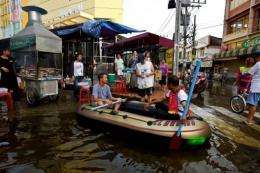Floods show what lies ahead for sinking Bangkok

The Thai capital, built on swampland, is slowly sinking and the floods currently besieging Bangkok could be merely a foretaste of a grim future as climate change makes its impact felt, experts say.
The low-lying metropolis lies just 30 kilometres (18 miles) north of the Gulf of Thailand, where various experts forecast sea level will rise by 19 to 29 centimetres (7 to 11 inches) by 2050 as a result of global warming.
Water levels would also increase in Bangkok's main Chao Phraya river, which already overflows regularly.
If no action is taken to protect the city, "in 50 years... most of Bangkok will be below sea level," said Anond Snidvongs, a climate change expert at the capital's Chulalongkorn University.
But global warming is not the only threat. The capital's gradual sinking has also been blamed on years of aggressive groundwater extraction to meet the growing needs of the city's factories and its 12 million inhabitants.
As a result Bangkok was sinking by 10 centimetres a year in the late 1970s, according to a study published last year by the World Bank, the Asian Development Bank (ADB) and the Japan Bank for International Cooperation.

That rate has since dropped to less than one centimetre annually, they said, thanks to government measures to control groundwater pumping.
If those efforts continued, the report authors said, they hoped the subsidence rate could slow by another 10 percent each year.
But Anond disputed their projections, saying Bangkok was still sinking at "an alarming rate" of one to three centimetres per year.
While scientists may argue over the exact figures, they agree about what lies in store for the sprawling megacity.
"There is no going back. The city is not going to rise again," said the ADB's lead climate change specialist David McCauley.
Faced with the combined threats of land subsidence and rising temperatures and sea levels, the World Bank has predicted that Bangkok's flood risk will increase four-fold from now by 2050.
And the Organisation for Economic Cooperation and Development has classified the Thai capital among the 10 cities in the world facing the biggest potential impact from coastal flooding by 2070.
For now, Bangkok is relying on a complex system of dykes, canals, locks and pumping stations to keep the rising waters at bay.
The flood protection efforts, however, failed to prevent an onslaught of run-off water from the north from swamping at least one-fifth of the capital.
The murky floodwaters, triggered by three months of heavy monsoon rains, are edging in on Bangkok's glitzy downtown area, threatening luxury hotels, office buildings and shopping malls.

Rapid urbanisation is one reason why the inundations are affecting the sprawling city so badly, according to experts.
As the area that needs flood protection gets larger and more built-up, the water "has fewer places to go", said Francois Molle, a water management expert at France's Institut de Recherche pour le Developpement.
Molle said that in the long term, Bangkok would eventually be under water. "The only question is when."
Experts say Thai authorities must address the capital's land use and planning challenges and consider relocating factories or industrial parks in flood-prone areas.
Or even moving the entire city.
"It may be appropriate for the people who want to be dry 24 hours a day, 365 days a year, to be setting up a new city," said Anond.
"We do have areas where we can develop a new city that would be completely dry. There's a lot of land in this country," he said.
It may sound like a drastic scenario, but there is little doubt that Bangkok will have to act if it wants to avoid the fate of the fabled sunken city of Atlantis.
"To remain where it is, the city will need better protection," said Robert Nicholls, a professor of coastal engineering at Britain's University of Southampton.
He said he expected Bangkok's current flood misery to "trigger massive investment in defences over the next 10 to 20 years".
Dealing with the phenomenon will be expensive elsewhere too. Across the Asia-Pacific region the ADB has estimated it will cost a minimum of $10 billion a year to adapt to climate change.
(c) 2011 AFP

















